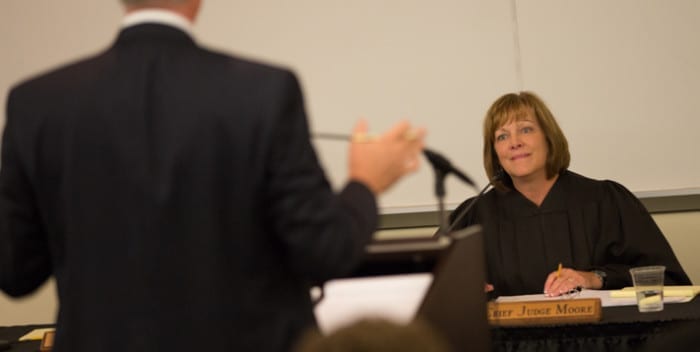Concordia Hosts Nebraska Court of Appeals
by Savanah Baker and Ryan Trueblood
Concordia hosted the Nebraska State Court of Appeals on Sept. 16 in the Thom Leadership Education Center auditorium, allowing students, faculty, community members and local high school students to see how the justice system works and the proceedings of an appeals court.
“We want (students) to understand the judicial branch, and this is a great opportunity to do so,” said Chief Judge Frankie Moore.
The court consisted of two sessions, one in the morning and one in the afternoon, each with four cases. The afternoon session averaged 78 Concordia students in attendance per case.
Between sessions, a luncheon was held for the judges, as well as their clerks and guests. This gave an opportunity for the judges to interact with community members, local institutions, students and faculty of Concordia.
“I only attended the first case of the afternoon session, but… I wish I had been able to stay for more, because it was really interesting to listen to the two sides presenting their evidence as to why their claim was correct,” said Rebecca Schiffer, a junior studying business administration and minoring in marketing and computer science. “As a business student, it was interesting to hear about a business issue relating to H(uman) R(esources).”
Concordia is not the first campus to host the Court of Appeals. The education outreach of the court, the College Campus Initiative, has been to one or two campuses per year since 2012 and is scheduled through 2017 with hopes to continue many years after, according to Moore.
While students attend to expand their education, attorneys and their clients come to the Court of Appeals to further their attempts at seeking justice. The court’s most common cases are domestic, while civil cases make up the lowest percentage of cases presented.
The four afternoon cases were various domestic disputes, including a man appealing his termination from a job due to his disability, witness tampering, child abuse resulting in a custody dispute and alleged negligence resulting in a fire that burned down a neighbor’s property.
According to Irwin and Judge Everett O. Inbody, the appeals system is regimented so that each case
receives the same amount of time. The applicant’s lawyer gets 10 minutes to present his or her case. The judges can ask questions, the lawyer answers and then proceeds with his or her case. The lawyer can reserve any remaining time within two minutes for rebuttal.
The opposing lawyer is then given a 10 minute response time to state his or her case and clarify items but cannot reserve any time for a rebuttal. Once both sides have presented, the court asks final questions, and the lawyers are dismissed.
According to Judge Francie C. Riedmann, each judge is given a brief beforehand, but the set of 10 minutes for the appeal is the only time that the attorneys have to present their appeal. These critical 10 minute segments determine if the lower court’s decision will be upheld, overturned or sent back for a retrial of the case.
The court consists of six judges, each representing their districts, divided equally between the two
sessions. This panel of three judges is used to avoid any bias or unlawful decision, according to Inbody.
“When we present the position in a case, and someone thinks you are not following the law or that a personal experience is influencing the direction, they speak up and we talk about it and most of the time we come to a consensus of which direction we should go,” Judge Michael Pirtle said.
In the afternoon session of the appeals, Judge Riko Bishop and Pirtle accompanied Moore on the bench.
“We try to honestly look at the law and apply it to the facts and render fair decisions,” said Bishop.
Other members of the court consisted of the judges’ clerks, a bailiff and a court reporter/photographer. State marshals took care of the security, and admittance into the court was only allowed between each hearing.
The judges will deliberate and have their official opinions posted between 60 and 90 days later, according to Inbody. Depending on the complexity of the cases, these decisions can come as soon as 30 days or as late as two years before hearing an official opinion from the panel of judges.
Each judge represents a different district, which means that communication after court days is limited to a secure-access system, where they deliberate and clarify points before creating their decision, according to Irwin.
A two-thirds majority vote is required to win an appeal. According to the judges, getting a majority vote in the appeal court with three judges is easier than getting one in the Supreme Court with seven.
The three judges make sure that they are well-informed about the case prior to the hearings.
“Before we got here today, we reviewed the records of the case, the briefs the attorneys submitted and one of us has been assigned as the author judge and did additional research and homework so that we have a pretty good idea of what the case is coming into it,” Moore said.
She explained that the author judge is the one who writes the statement regarding the decision the court makes on the appeal. To prevent any indiscretions during the appeal hearing, the author judge is not revealed until the statement is released.
According to the Court of Appeals’ website, the Court of Appeals was founded in 1991 and now handles approximately 1,100 cases a year.














